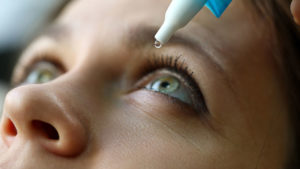December 15, 2022
By Dwight Akerman, OD, MBA, FAAO, FBCLA, FIACLE
 Several clinical trials (Kinoshita et al., Kinoshita et al., Tan et al., and Wan et al.) and meta-analyses (Yang et al., Wang et al., Sanchez-Gonzalez et al.) have reported that topical low-dose atropine combined with orthokeratology lenses are more effective in controlling axial elongation than using OrthoK lenses alone for children with myopia.
Several clinical trials (Kinoshita et al., Kinoshita et al., Tan et al., and Wan et al.) and meta-analyses (Yang et al., Wang et al., Sanchez-Gonzalez et al.) have reported that topical low-dose atropine combined with orthokeratology lenses are more effective in controlling axial elongation than using OrthoK lenses alone for children with myopia.
The most recently published meta-analysis included eight studies (Yang et al.). However, of these eight studies, two included only one-month results, and one included six-month results. Studies found that the combination therapy was more effective than OrthoK lenses alone only in the first few months, but there was no difference in the later stages of the combination. In addition, the study design of all these clinical trials was not randomized double-blinded, placebo-controlled studies, but rather they were randomized not-blinded, retrospective, or non-parallel studies.
Yu et al. conducted a randomized, double-blinded, placebo-controlled one-year trial to evaluate the additive effects of OrthoK lenses and 0.01% atropine on slowing axial elongation in central mainland Chinese children with myopia.
The researchers included 53 children with myopia (spherical equivalent refraction, -1.00D to -4.00D in a prospective, randomized, double-blinded, placebo-controlled trial and randomly assigned them to treatment with a combination of OrthoK and 0.01% atropine (n=27; mean age, 10.07 years) or OrthoK and a placebo eye drop (n=26; mean age, 9.80 years). The children wore the lenses every night for eight hours and underwent axial length (AL), corneal power, and anterior chamber depth measurements at baseline and one-day, one-week, two-, four-, eight-, and 12-month follow-up visits. Treatment compliance was determined by the amount of eye drops that remained during follow-up visits.
Participants who used atropine 0.01% in conjunction with OrthoK experienced an axial elongation of 0.10 mm compared with 0.20 mm in participants treated with the placebo drop after 12 months. The change in AL between the two groups was only significantly different during the first four months.
Pupil diameter increased by 0.45 mm at the four-month visit and remained stable in participants treated with OrthoK and atropine 0.01%. This metric remained stable in participants treated with the placebo. Both groups’ accommodative amplitude remained stable from baseline to 12 months.
The researchers concluded: “The mechanisms by which the combination of OrthoK lens and 0.01% atropine was more effective in slowing axial elongation than OrthoK lens alone remains uncertain. Atropine 0.01% in the combination group significantly increased pupil diameter in children, which may facilitate the effect of OrthoK lenses to slow axial elongation through both pharmacological and optical mechanisms.”
Furthermore, the researchers wrote that studies including higher atropine concentrations, such as 0.05%, combined with OrthoK lenses and a treatment arm with only low-dose atropine should be conducted in the future.
Abstract
Combination of Orthokeratology Lens with 0.01% Atropine in Slowing Axial Elongation in Children with Myopia: A Randomized Double-Blinded Clinical Trial
Shiao Yu, Liping Du, Na Ji, Binbin Li, Xuena Pang, Xiuhong Li, Nana Ma, Congcong Huang, Aicun Fu
Background: To evaluate the additive effects of orthokeratology (OrthoK) lenses and 0.01% atropine on slowing axial elongation in myopic children.
Methods: A prospective, randomized, double-blinded, placebo-controlled trial was conducted over a 12-month period. Sixty children aged 8 to 12 years with spherical equivalent refraction from -1.00 to -4.00 D who had been wearing OrthoK lenses successfully for 2 months (as baseline) were randomly assigned in a 1:1 ratio to combination group (combination of OrthoK lens and 0.01% atropine eye drops) and control group (combination of OrthoK lens and placebo). The primary outcome was change in axial length, along with secondary outcomes including change in pupil diameter (PD) and accommodative amplitude (AMP) at 12 months (measured at 4-month intervals).
Results: After 12 months, the overall axial elongation was 0.10 ± 0.14 mm and 0.20 ± 0.15 mm (p = 0.01) in the combination and control groups, respectively. The change in axial length in the two groups showed significant differences only in the first four months (median [Q1, Q3] (95% CI), -0.01 mm [-0.07, 0.05] (-0.06, 0.04) vs. 0.04 mm [0.00, 0.10] (0.02, 0.09); p = 0.04), but no difference thereafter. Multivariate linear regression analysis showed that the axial elongation was significantly slower in the combination group than in the control group (standard β = -0.10, p = 0.02). PD significantly increased by 0.45 mm [0.20, 0.68] at the 4th month visit (p < 0.001) and then remained stable in the combination group. The PD in the control group and AMP in the two groups remained stable from baseline to 12 months (all p > 0.05).
Conclusion: The combination therapy was more effective than the OrthoK lens alone in slowing axial elongation after 12 months of treatment, mainly in the first 4 months.
Yu, S., Du, L., Ji, N., Li, B., Pang, X., Ma, N., … & Fu, A. (2022). Combination of orthokeratology lens with 0.01% atropine in slowing axial elongation in children with myopia: a randomized double-blinded clinical trial. BMC Ophthalmology, 22(1), 1-9.
DOI: https://doi.org/10.1186/s12886-022-02635-0













